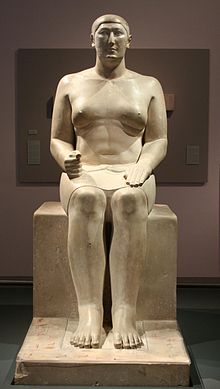
A mastaba, also mastabah or mastabat) is a type of ancient Egyptian tomb in the form of a flat-roofed, rectangular structure with inward sloping sides, constructed out of mudbricks or limestone. These edifices marked the burial sites of many eminent Egyptians during Egypt's Early Dynastic Period and Old Kingdom. Non-royal use of mastabas continued for over a thousand years.
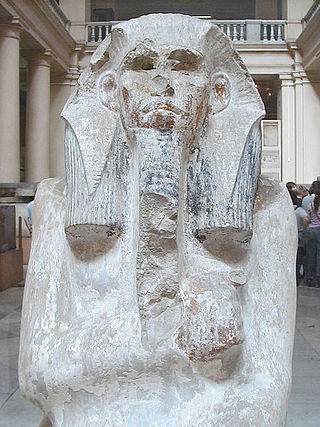
Djoser was an ancient Egyptian pharaoh of the 3rd Dynasty during the Old Kingdom, and was the founder of that epoch. He is also known by his Hellenized names Tosorthros and Sesorthos. He was the son of King Khasekhemwy and Queen Nimaathap, but whether he was also the direct successor to their throne is unclear. Most Ramesside king lists identify a king named Nebka as preceding him, but there are difficulties in connecting that name with contemporary Horus names, so some Egyptologists question the received throne sequence. Djoser is known for his step pyramid, which is the earliest colossal stone building in ancient Egypt.

Merenre Nemtyemsaf was an Ancient Egyptian pharaoh, fourth king of the Sixth Dynasty. He ruled Egypt for six to 11 years in the early 23rd century BC, toward the end of the Old Kingdom period. He was the son of his predecessor Pepi I Meryre and queen Ankhesenpepi I and was in turn succeeded by Pepi II Neferkare who might have been his son or less probably his brother. Pepi I may have shared power with Merenre in a co-regency at the very end of the former's reign.

The Fourth Dynasty of ancient Egypt is characterized as a "golden age" of the Old Kingdom of Egypt. Dynasty IV lasted from c. 2613 to 2494 BC. It was a time of peace and prosperity as well as one during which trade with other countries is documented.

Djedkare Isesi was a pharaoh, the eighth and penultimate ruler of the Fifth Dynasty of Egypt in the late 25th century to mid-24th century BC, during the Old Kingdom. Djedkare succeeded Menkauhor Kaiu and was in turn succeeded by Unas. His relationship to both of these pharaohs remain uncertain, although it is often conjectured that Unas was Djedkare's son, owing to the smooth transition between the two.
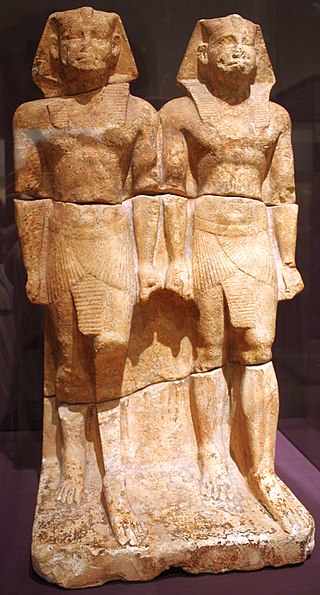
Nyuserre Ini was an Ancient Egyptian pharaoh, the sixth ruler of the Fifth Dynasty during the Old Kingdom period. He is credited with a reign of 24 to 35 years depending on the scholar, and likely lived in the second half of the 25th century BCE. Nyuserre was the younger son of Neferirkare Kakai and queen Khentkaus II, and the brother of the short-lived king Neferefre. He may have succeeded his brother directly, as indicated by much later historical sources. Alternatively, Shepseskare may have reigned between the two as advocated by Miroslav Verner, albeit only for a few weeks or months at the most. The relation of Shepseskare with Neferefre and Nyuserre remains highly uncertain. Nyuserre was in turn succeeded by Menkauhor Kaiu, who could have been his nephew and a son of Neferefre.

The Giza pyramid complex in Egypt is home to the Great Pyramid, the Pyramid of Khafre, and the Pyramid of Menkaure, along with their associated pyramid complexes and the Great Sphinx. All were built during the Fourth Dynasty of the Old Kingdom of ancient Egypt, between c. 2600 – c. 2500 BC. The site also includes several temples, cemeteries, and the remains of a workers' village.

The pyramid of Unas is a smooth-sided pyramid built in the 24th century BC for the Egyptian pharaoh Unas, the ninth and final king of the Fifth Dynasty. It is the smallest Old Kingdom pyramid, but significant due to the discovery of Pyramid Texts, spells for the king's afterlife incised into the walls of its subterranean chambers. Inscribed for the first time in Unas's pyramid, the tradition of funerary texts carried on in the pyramids of subsequent rulers, through to the end of the Old Kingdom, and into the Middle Kingdom through the Coffin Texts that form the basis of the Book of the Dead.

The Tomb of Perneb is a mastaba-style tomb from ancient Egypt, built during the reigns of Djedkare Isesi and Unas, in the necropolis of Saqqara, north of Pharaoh Djoser's Step Pyramid and about 30 kilometers south of Giza, Egypt. It was the tomb of Perneb, and from the size and placement of the tomb he might have been a court official or royal family member.
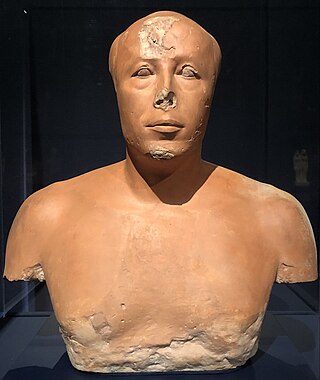
Ankhhaf was an Egyptian prince and served as an overseer during the reign of the Pharaoh Khufu, who is thought to have been Ankhhaf's half-brother. One of Ankhaf's titles is also as a vizier, but it is unknown which pharaoh he would have held this title under. He lived during Egypt's 4th Dynasty.

Queen Meresankh III was the daughter of Hetepheres II and Prince Kawab and a granddaughter of the Egyptian pharaoh Khufu. She was the wife of King Khafre.

Nefermaat I was an ancient Egyptian prince, a son of king Sneferu. He was a vizier possessing the titles of the king's eldest son, royal seal bearer, and prophet of Bastet. His name means "Maat is beautiful" or "With perfect justice".
Djedefhor or Hordjedef was a noble Egyptian of the 4th Dynasty. He was the son of Pharaoh Khufu and his name means "Enduring Like Horus".
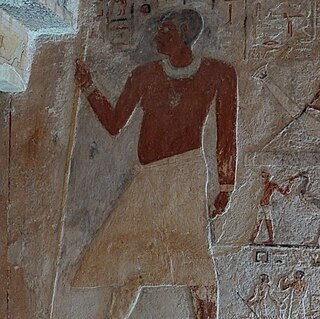
Kawab is the name of an ancient Egyptian prince of the 4th Dynasty. He was the eldest son of King Khufu and Queen Meritites I. Kawab served as vizier and was buried in the double mastaba G 7110–7120 in the east field which is part of the Giza Necropolis.
Khufukhaf I was an ancient Egyptian prince and vizier of the 4th Dynasty.

Rahotep was a prince in ancient Egypt during the 4th Dynasty. He was probably a son of Pharaoh Sneferu and his first wife, although Zahi Hawass suggests his father was Huni.
Nefermaat II was a member of the Egyptian royal family during the 4th Dynasty and vizier of Khafre.

Rashepses was a vizier from the Fifth Dynasty of Egypt. Rashepses was vizier under Djedkare Isesi. A letter directed to Rashepses has been preserved. This decree is inscribed in his tomb in Saqqara. As vizier he was one of the most important Ancient Egyptian officials. In his tomb are many titles recorded. It seems that he was first overseer of the scribes of the royal documents, overseer of the two granaries and overseer of all royal works. These are all very important titles, making him an influential official at the royal court. At the final stage of his career he became vizier. The vizier title is only preserved in two letters that are copied on the decoration of the tomb. It seems that most of his tomb was finished and after all that, he was promoted.
Persenet was an ancient Egyptian queen consort of the 4th Dynasty. She may have been a daughter of King Khufu and a wife of King Khafre. She is mainly known from her tomb at Giza.
Kaemtjenent was an ancient Egyptian official under pharaoh Djedkare Isesi in the late Fifth Dynasty, during the Old Kingdom period.
